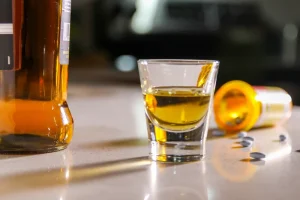Medications for Alcohol Use Disorder

Many people have been where you are and have successfully treated their depression and alcohol use disorder. In one 2018 study, 60 people who recently detoxed from alcohol experienced fewer depressive symptoms after participating in Sudarshan Kriya Yoga for just 2 weeks. However, evidence suggests that more than 25% of people in treatment have experienced a substance-induced depressive episode in their lifetime. One study of people with both AUD and depression undergoing treatment for both conditions found that the majority of symptom improvement for both conditions happened during the first three weeks of treatment.
How we reviewed this article:
Medications such as SSRI and SNRI inhibitors, buspirone, benzodiazepines, diphenhydramine, propranolol, tamoxifen, prazosin, doxazosin, that help to block the stress-induced anxiety may also reduce alcohol consumption. Among them, prazosin and doxazosin are known medications for the treatment of high blood pressure. Prazosin (1.0 or 1.5 mg/kg, i.p) or vehicle was administered in alcohol preferring (P) rats and anxiety-like behavior was measured. Prazosin showed promising results in treating alcoholism by blocking α-1 adrenoreceptors in rats. Intracerebroventricular (ICV) administration of prazosin (2 and 6 nmol) or systemically (1 mg/kg) on antagonist yohimbine (1.25 mg/kg)-induced reinstatement of alcohol craving in rats was assessed by using footshock stress. Yohimbine-induced reinstatement of alcohol seeking was reduced substantially by the ICV and systemic prazosin (50 and 69 % decreases) respectively.
Health effects

Although taking testosterone may help your ED, it is often unhelpful if your ED is caused by circulatory or nerve problems. Taking testosterone also may lead to side effects, including a high red blood cell count and problems urinating. Pragmatically, we accept that minimizing the active psychological work of the therapy would be desirable (eg, therapy time is expensive) and scientifically, doing so would allow drug effects and dose to be better identified. Critically however, any such therapy minimization should not be allowed to jeopardize patient safety (Johnson et al, 2008). A future challenge will be to learn how psychological interventions can maximize the advantages of the psychedelic state.

How can addiction harm other people?
One received AR I+ escitalopram (ARI 5–15mg + escitalopram 10–20mg/day for 6 weeks) and other escitalopram alone. Both escitalopram alone and ARI + escitalopram group were shown to reduce Beck Depression Inventory and clinical global index-severity (CGI-S) scores, however, reduced alcohol craving in ARI + escitalopram group. These findings suggest that the effects of ARI on anterior cingulate cortex might mediate the successful treatment of alcohol dependence in patients with MDD (Han et al., 2013). Myrick et al, evaluated the effects of aripiprazole on alcohol cue-induced brain activation and drinking in alcoholics.
S1 Text. Supporting information content containing the full study protocol and meta-analytic outputs.
In the self-administration trained rats, gabapentin pretreatment (60mg/kg) resulted in escalation in alcohol self-administration suggesting that gabapentin may mediate the potentiation of alcohol effects by increasing alcohol self-administration in non-dependent populations (Besheer et al., 2016). Schematic diagram of the FDA-approved drugs and other medications, such as anticonvulsants and some off-label medications, that are used or repurposed for the treatment of AUDs. This scheme also shows the underlying pathways through which these medications exert their inhibitory effects on alcohol intake and/or craving. Two reviewers independently extracted study-level descriptive data (SG and either GA or EH) and outcome data (SG and MB). Today in the United States, alcohol dependence is almost always treated in an outpatient setting, where continued drinking and poor treatment attendance can be major obstacles to observing periods of abstinence. Clinicians are typically expected to decide how to treat depression in patients who are actively drinking, without benefit of observing that patient during an extended period of abstinence.

Comorbid AnxD and AUD Pharmacological Treatment Considerations
- Monoamine oxidase inhibitors (MAOIs) are a class of antidepressants typically reserved to treat depression that is not responding to other medications, but they can cause serious interactions.
- Systemic administration of OT reduces alcohol preference and intake in a variety of drinking models in rats (MacFadyen et al., 2016) and mice (King et al., 2017).
- Although taking testosterone may help your ED, it is often unhelpful if your ED is caused by circulatory or nerve problems.
In addition to the liver, alcohol contributes to more than 200 diseases, including alcoholic dementia, injury-related health conditions and cancers, falls and automobile-related accidental injuries (NIAAA, 2016a). Binge drinking, in the United States, is defined as a pattern of alcohol consumption that brings the blood alcohol concentration (BAC) level to 0.08 g/dL or above within two hours (CDC, 2016). According to the national surveys, more than 90% of American adults who drink excessively reported binge drinking in the past 30 days (NIAAA, 2016b). Many binge drinkers may not be alcohol dependent, but their binge drinking habits make them susceptible to several health problems. Empirical data that support effective treatments for co-occurring depression and alcohol dependence are long does drinking make your depression worse overdue. Comorbid prevalence rates are formidable, and numerous reports describe patients with comorbid depression and alcohol dependence as clinically more severely ill and more difficult to keep well than patients who are either depressed or alcohol-dependent.
Of these, most indicated they would appreciate the opportunity to speak to someone—but only one suggested a psychiatrist. As a clinician long committed to the view that neuroscience should inform psychiatry, psychedelics have always looked like a serious opportunity. Their structure and pharmacology inspired a generation of neurochemists to understand neurotransmitters and their receptors. And, the very idea that drugs could usefully change the experience of distressed patients with psychiatric disorders underpinned the revolution in psychopharmacology in the three decades from 1950. However, the ‘illegal’ status of psychedelics stopped serious research in humans until quite recently, as RLC-H has explained. Focusing on antidepressant action, psilocybin, and psychedelics more generally, share some similarities with conventional antidepressants (ie, serotonergic modulation); however, they also possess some important differences.
Stopponi et al. used genetically selected alcohol-preferring Marchigian Sardinian (msP) rats, and evaluated the effect of pregabalin on alcohol drinking and relapse with alcohol seeking, induced by stress or environmental conditioning factors (Stopponi et al., 2012). The results showed that treatment with pregabalin (0, 10, 30 and 60 mg/kg) given orally selectively reduced home cage alcohol drinking in msP rats. In the alcohol reinstatement model, pregabalin (0, 10 and 30 mg/kg) abolished alcohol seeking behavior elicited by the pharmacological stressor yohimbine, suggesting its role in the treatment of alcohol addiction. The effects of pregabalin were evaluated on nitroglycerin (NTG)-induced hyperalgesia in male Sprague-Dawley rats. Pretreatment of rats with pregabalin (10 – 30mg/kg, s.c) thirty minutes prior to NTG (10mg/kg, i.p) injection alleviated NTG-induced hyperalgesia and suppressed peripheral calcitonin-gene-related peptide (CGRP) (Di et al., 2015).
- The effects of pregabalin were evaluated on nitroglycerin (NTG)-induced hyperalgesia in male Sprague-Dawley rats.
- ABT-436 treatment reduced serum cortisol levels, however, no pharmacokinetic or pharmacodynamic interactions between ABT-436 and alcohol have been reported (Katz et al., 2016).
- Research has substantially improved understanding of the etiology, course, and treatment of co-occurring AUD and depressive disorders.
- For individuals already struggling with mental health issues, alcohol can turn manageable depression into a more severe and chronic condition.
Links to NCBI Databases
A multicentre trial found that AnxDs had a substantial influence on the course and severity of alcoholism in women (49). The women with AnxDs had faster dependence evolution, including earlier first drink onset and shifting to regular consumption and a greater incidence of abstinence symptoms. One potential explanation is that the reasons for using alcohol can differ by gender. For example, women might be more prone than men to self-medicate with alcohol for mood problems (50–52). Furthermore, empirical inspection of gender differences in stress-related drinking has shown that women report higher levels of stress and have a stronger link between stress and drinking (53, 54). Some researchers have suggested that the effects of psychotherapy may account for some of the pill placebo response observed in medication studies.
Major depressive disorder
They also showed the decreased blood alcohol levels in D-Lys3-GHRP-6 mice compared to control mice. Chronic alcoholism has become a major health issue both in developed and developing countries with heavy social, medical and economic burdens. Despite the available pharmacotherapies for the treatment of AUDs, there are no such medication and treatment methods that give a hundred percent cure rate. Many of these drugs and medicines are known to exhibit some deleterious side effects or are only effective in some conditions. The currently used FDA approved drugs include Disulfiram, Naltrexone, and Acamprosate.
About the author